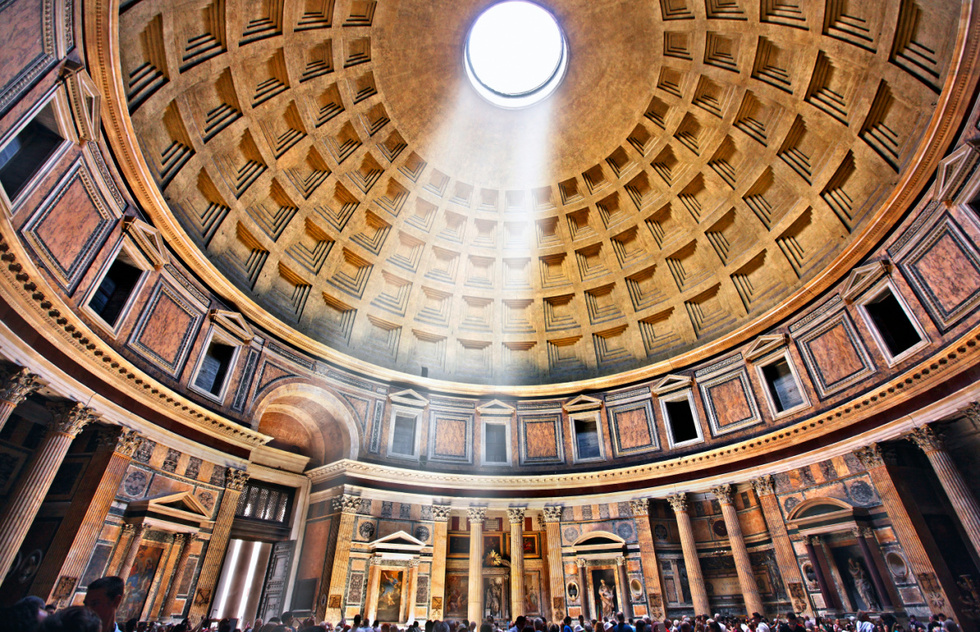After centuries—nay, millennia—of flinging open its mighty bronze doors free of charge, the Pantheon, one of the most-visited attractions in Rome, is now charging admission.
Effective this month, the inimitable landmark will collect a fee of €5 ($5.60) from each tourist who visits.
Located in the heart of Rome’s Centro Storico and part of a highly Instagrammable trifecta that also includes the Trevi Fountain and Piazza Navona, the Pantheon, or temple of all the gods, dates back to the first century BCE. The circular building, which more or less took its present shape in the second century CE, is capped by the world’s largest and oldest unreinforced concrete dome, a perfect sphere featuring an open oculus that measures 18 feet in diameter.
In the early 600s, the Pantheon was consecrated as a church—a status that largely saved the structure from the plundering and outright demolition that befell many of the city's other ancient monuments.
Visitors and worshippers could long walk in and out of the Pantheon unhindered. For the millions of travelers who visit Rome each year, ducking into the iconic building meant ticking off a Roman must-see without any forethought.
But the costs of ongoing maintenance, the need for crowd control—more than 9 million people visited in 2019—plus plain old euros and cents have finally prompted the new paid ticketing system.
It’s taken nearly 2,000 years to get to this point, so perhaps no one should expect a smooth transition. But even by the standards of this spectacular and spectacularly frustrating city, the rollout of the new admission system has been about as orderly as ancient bacchanalia.
Tickets are available onsite, but in-person wait times can be very long. You're better off securing admission in advance via the official Musei Italiani website, even though that process involves a labyrinthine registration and purchase rigmarole—so many clicks!—that makes Rome’s baroque churches seem streamlined by comparison.
Given the time and number of steps required to register, select a date and timed entry slot, and process payment, I strongly recommend getting Pantheon tickets online before you leave for your trip to Italy. Waiting to go to the website till you're in Rome—trying to manage everything on a handheld device while relying on a dodgy Wi-Fi signal amid the hubbub of the city—might make you want to hurl your smartphone into the nearest Bernini fountain.
A further source of confusion: Audio and guided tour tickets sold through the diocese’s website—which is way easier to land on than the Musei Italiani site—do not include the new €5 admission fee.
So if you want to take one of the diocese tours, you’ll have to book your timed entrance ticket first, then go to the diocese site to book your tour, assuming a tour is available for the same time slot. Otherwise, you could find yourself in possession of a tour to an attraction you are not allowed to enter.
This convoluted new system has arrived right in the middle of Rome’s (and the rest of Italy’s) record-breaking high season, when prices for plane tickets, hotel stays, restaurant meals, and groceries (just in case you were planning to save euros by packing a picnic lunch) have hit an all-time high.
Five euros to see the inside of the Pantheon isn’t likely to make or break anyone’s vacation, but the fee adds another wrinkle to an already stressful, costly season, especially since the new ticketing system will catch a lot of visitors off guard.
And the Pantheon isn't the first Roman attraction to cause headaches of this kind for tourists.
The Colosseum has had a timed, paid entrance system in place for years. As recently explained in the New York Times, critics of the Colosseum's system say that due to a lack of controls, tour operators and other third-party agents are able to use bots to snatch up huge batches of tickets online and bundle them into higher-priced guided or packaged tours, effectively boxing out thousands of tourists a day.
Right now, that doesn't appear to be happening with the Pantheon. Once I registered with the Musei website, I was able to reserve a same-day ticket. (The Colosseum, on the other hand, was fully booked for the next several days.)
The Pantheon's relatively good ticket availability may be short-lived, but for the moment, the Byzantine booking system may be too complicated for even the smartest bot to outwit.
The downside, of course, is that the system can be pretty confusing for human minds to figure out, too.
At least you can get a head start on reserving those Pantheon tickets at MuseiItaliani.it.
Elizabeth Heath is a coauthor of Frommer's Italy and Frommer's Rome, Florence, and Venice.







